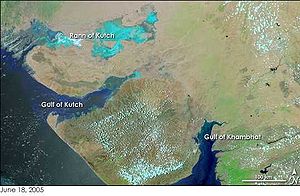वापस जायें / Back
Geography of India - Thar Desert and Rann of Kuchh
Thar Desert
Thar desert is an expanse of wavy sand dunes which is also called the great Indian desert. Some of it is in Rajasthan and soe in Pakistan. It extents in an area of 2,00,000 square kilometers. The western part of this is irrigated by the Indus. Arawali hills are in its south west and the Rann of Kuchh is to the south. Punjab in in the north east.
Reason for formation – This desert has been formed due to the absence of monsoon rains.
The meaning of Thar – Thar mean land which means a sand dune.
The formation of Thar Desert – The sand of the desert is from the rocks of Cambrian era. (igneous rocks like granite which are more than 38 crore years old) along with the old submerged rocks which are from 25 crore to 57 lakh years old. In addition the alluvium brought by the rivers flowing into it in modern times is also in it. The sand on the surface is brought by the wind. The surface is undulating and it is divided into small and big sand dunes and sand plains or Bhakhar. The sand dunes keep changing shapes forever. Some salt water lakes (Pyala) are found in this areas which are called Dhand in the local Language.
Rain and temperature – Annual rainfall in the west is 100 mm or less and in the east approximately 500 mm. 90% of the total rainfall is in the period of Monsoon which is from July to September. May and June are the hottest months when the temperature reaches 50°C. The minimum temperature in the month of January is 5°to 10°C. In the months of May and June winds blow at a velocity of 140 to 150 Kilometers per hour.
Flora and Fauna – Mostly herbs and shrubs are found in the desert. Trees are seen at some places. In the hills Arabic Acacia, and Euphorbia are found. Trees of Prosopis cineraria (Khejri) are found in the plains. Black buck, Chinkara and birds of prey and other birds like Titar and Bater are found in the grass lands. Among the migratory birds are Bhatta Titar, duck and Kalhans. This desert is also the habitat of the Great Indian Bustard which is on the verge of extinction. Five main breeds of cows are found in the Thar desert. The Tharparkar cow yields the maximum milk, while the Kankre breed is used as a beast of burden and also for milk. Sheep rearing is done year for wool. Camels are used both for transport and agriculture. Most people live in rural areas with low density.
Life style – Both Hindus and Muslims live hear. The population is divided on complex economic and social bases. Nomads live hear and engage in animal husbandry, crafts, and trade. Grass is the main natural produce which is used as cattle feed. Local people also make medicines from it and oil and soap is also made. The rain water is stored in tanks, which is used for drinking and other domestic purposes.
Increase in area –
The area of Thar desert is increasing at the rate of half kilometer per year. The most surprising fact is that 32% of the land area is badly degraded. Out of this 24% is desert area. Rajasthan is in the clutches of desertification. National soil survey and land use planning bureau says that the area of Thar desert which was, 1,96,150 square kilometers in 1996 has increased to 2,08,111 square kilometers. More and more land has become barren because of damage to the forest wealth of the Arawalis. Felling of trees has happened for the needs of firewood of the people of this area.
Rann of Kuchh

Rann of Kuchh is in the north and east of the Kucchh district fo Gujarat. This is a salty swamp and a barren land in the western middle India and in the southern Pakistan.
The Rann of Kuchh is spread in approximately 23,300 square kilometers and is located in Gujarat adjacent to the Pakistan border. The little Rann of Kauchh is on the north east of the gulf and is spread over 5,100 square kilometers in Gujarat.
It is mainly a region which was under the ocean and has been created by the deposit of alluvium for centuries and has beocme a closed area. The Rann of Kuchh is a narrow part of the ocean itself which has risen above the original surface and therefore has separated from the ocean. During the period of Alexander it was a lake in which navigation could be done but now it is a swampy area which is covered with water in monsoons.
This area becomes unapproachable from March to October. The habitation is limited to low and separate hills. Due to an earthquake in the year 1819 the northern Rann rose above the rest of it. As a result the middle part dried up and the borders became swampy. On the drying up of the swamps the salt grains are formed which shine in the sun.